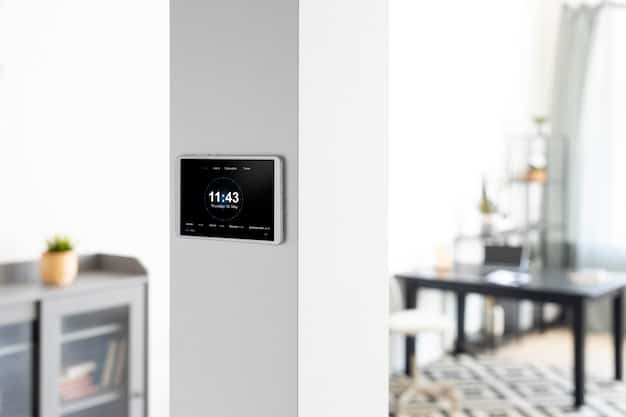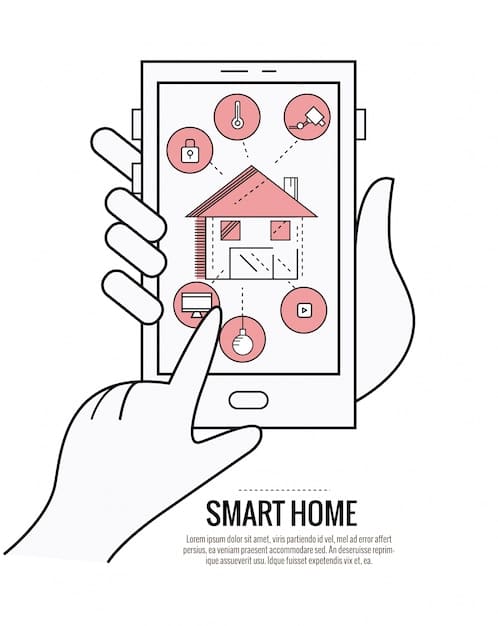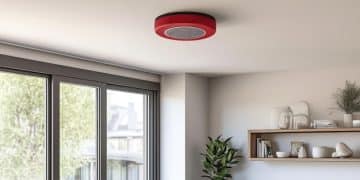Smart Home Integration: Connecting Devices for Seamless Control

Anúncios
Achieving seamless smart home integration involves strategically connecting diverse devices, from lighting and thermostats to security cameras and entertainment systems, to operate cohesively through unified platforms or hubs, enhancing convenience and efficiency in modern living spaces.
The vision of a fully autonomous living space, once confined to science fiction, is rapidly becoming a tangible reality. At the heart of this transformation lies smart home integration: connecting all your devices for seamless control. This intricate ecosystem goes beyond mere automation, promising unparalleled convenience and an intuitive interaction with our environment. But how exactly does this interconnected future work, and what are the essential considerations for building a truly smart home?
Understanding the Core of Smart Home Integration
Smart home integration is fundamentally about creating a unified network where various intelligent devices can communicate, share data, and respond to commands, both automated and manual. It’s not just about having individual smart gadgets; it’s about making them work together in harmony, eliminating fragmented control and disparate apps.
The concept begins with identifying the central nervous system of your smart home, typically a hub or a central software platform. This hub acts as a translator, allowing devices from different manufacturers, speaking different protocols, to understand each other. Without such a mechanism, your smart bulbs might not talk to your smart thermostat, severely limiting the potential for true automation.
The Key Pillars of Interconnectivity
Achieving seamless integration hinges on several critical components working in concert. Understanding these pillars is crucial for anyone embarking on or expanding their smart home journey.
- Protocols: These are the languages devices use to communicate. Common examples include Wi-Fi, Bluetooth, Zigbee, Z-Wave, and Thread. Choosing devices that adhere to compatible protocols or utilizing a hub that bridges these protocols is essential.
- Platforms: These are the software ecosystems that tie everything together. Apple HomeKit, Google Home, Amazon Alexa, and Samsung SmartThings are leading examples, offering overarching control and automation capabilities.
- Interoperability: This refers to the ability of devices from different brands to work together. While open standards like Matter aim to improve this, it remains a significant consideration when purchasing new smart home technology.
The beauty of well-executed integration lies in its ability to abstract away the complexity of these underlying technologies, presenting the user with an intuitive and responsive control experience. It transforms a collection of smart gadgets into a truly “smart” home, capable of anticipating needs and responding intelligently to changes in its
environment.
Choosing the Right Smart Home Ecosystem and Hub
The foundation of effective smart home integration lies in selecting the appropriate ecosystem and a capable central hub. This decision will largely dictate the compatibility and functionality of your devices, influencing everything from daily routines to future expansion possibilities.
There are several prominent smart home ecosystems, each with its strengths and weaknesses. Google Home, centered around the Google Assistant, excels in voice control and integrates deeply with Google’s suite of services. Amazon Alexa offers vast device compatibility and a robust skill set, making it highly versatile. Apple HomeKit provides a strong emphasis on privacy and security, seamlessly integrating with Apple’s device ecosystem. Beyond these, dedicated hubs like Samsung SmartThings or Hubitat offer more advanced local processing and intricate automation capabilities, often appealing to tech enthusiasts seeking deeper control.
Evaluating Your Needs and Preferences
Before committing to an ecosystem, consider your existing technology, your comfort level with different interfaces, and your primary goals for smart home integration. Are you heavily invested in Apple products? Do you prefer interacting with a voice assistant? Or perhaps you prioritize local control and complex automations?
- Voice Assistant Preference: Decide if you prefer Amazon Alexa, Google Assistant, or Apple’s Siri, as this will naturally steer you towards a compatible ecosystem.
- Device Compatibility: Research which devices you own or plan to buy are compatible with your chosen platform. Some ecosystems are more open than others.
- Privacy and Security: Evaluate the privacy policies and security features of each platform. This is increasingly important as more personal data flows through your smart home.
A smart home hub, whether a dedicated device or a software solution integrated into a smart speaker, plays a crucial role. It acts as the central brain, facilitating communication between disparate devices and enabling complex routines. Opting for a hub that supports multiple communication protocols (like Zigbee, Z-Wave, and Wi-Fi) offers greater flexibility and future-proofing, allowing you to incorporate a wider range of devices without compatibility headaches. This strategic choice early on can significantly streamline your integration journey, preventing frustration down the line.
Integrating Smart Lighting and Climate Control
Smart lighting and climate control are often the gateway to a fully integrated smart home, immediately showcasing the tangible benefits of connected living. Beyond simple on/off functions, their integration opens up a world of automation scenarios that enhance comfort, energy efficiency, and ambiance.
For smart lighting, systems like Philips Hue, Lutron Caseta, or Nanoleaf allow for dynamic control over brightness, color, and even color temperature. When integrated, these lights can respond to various triggers: dimming automatically when you start a movie, brightening as you wake up, or even changing color to reflect the weather outside. The magic happens when they converse with other devices.
Automating Comfort and Efficiency
Consider the synergy between smart lighting and climate control. Thermostats like Ecobee or Nest learn your preferences and adjust temperatures accordingly. True integration allows them to work in tandem. For instance, if your smart thermostat detects you’ve left the house, it can signal your lights to turn off, rather than relying on separate routines. Similarly, if a smart sensor detects an open window, it could temporarily pause the HVAC system to prevent energy waste.
Here are some powerful integration examples:
- “Good Morning” Routine: Lights gradually brighten, shades slowly open, and the thermostat adjusts to your preferred morning temperature, all triggered by your alarm or a set time.
- “Movie Night” Scene: With a single command, lights dim to a specific percentage and color, the thermostat adjusts for comfort, and even your smart TV can power on to a streaming service.
- Energy Saving Protocols: Presence sensors or routines can ensure lights and HVAC systems only operate when rooms are occupied, minimizing energy consumption.
The ability to create custom scenes and routines across lighting and climate offers unparalleled personalization. It transforms static environmental controls into a dynamic system that anticipates your needs, adapting to your lifestyle and contributing to both comfort and significant energy savings. This level of synchronization is a prime example of integration’s power.

Enhancing Security and Surveillance with Integration
Integrating security and surveillance devices is arguably one of the most compelling reasons to build a smart home. Beyond standalone alarms and cameras, a connected security ecosystem provides a proactive, layered defense, offering peace of mind through enhanced monitoring and automated responses.
Modern smart security encompasses a variety of devices, from door/window sensors and motion detectors to smart locks and video doorbells. When these are integrated, they don’t just alert you to an event; they can trigger a cascade of actions designed to deter intruders and gather evidence. Imagine your smart lock notifying you of an unauthorized entry, simultaneously triggering indoor sirens, turning on all lights in the house, and recording footage from multiple cameras.
Creating a Proactive Defense System
The power of integrated security lies in its ability to automate responses based on detected events. This moves beyond passive monitoring to active deterrence and alerts. Consider these integration scenarios:
- Automated Deterrence: If a motion sensor outside detects an unexpected presence at night, integrate it to turn on exterior lights, activate a smart speaker to play a “barking dog” sound, and send instant push notifications to your phone.
- Emergency Protocol: In the event of a smoke alarm activation (if integrated), smart lights could flash red to guide occupants to exits, smart locks could automatically unlock for emergency services, and a pre-recorded message could play over smart speakers.
- Remote Monitoring and Access: Integrated video doorbells allow you to see and speak to visitors remotely, and smart locks enable you to grant temporary access, all from your smartphone, enhancing both security and convenience for deliveries or guests.
Selecting devices that are natively compatible with your chosen smart home ecosystem or that offer strong third-party integration is crucial. Prioritize security camera systems that offer cloud storage and clear night vision, and smart locks with robust encryption. The ultimate goal is to create a responsive security network that minimizes your reaction time to potential threats, turning your home into an intelligent fortress.
Integrating Entertainment and Appliance Control
Beyond the essentials of lighting, climate, and security, smart home integration extends its reach into the realms of entertainment and appliance control, transforming everyday experiences into seamless, automated interactions. This level of connectivity elevates convenience, enabling your home to truly cater to your lifestyle.
Integrating entertainment systems can range from controlling your smart TV and sound system with voice commands to setting up multi-room audio experiences. Devices like smart TVs, streaming sticks, AV receivers, and smart speakers from brands like Sonos or Google/Amazon become interconnected. Imagine saying “movie night,” and your TV turns on, the soundbar activates, and specific playlists or streaming apps automatically launch, all in perfect sync.
Streamlining Daily Routines
Appliance integration, while perhaps less theatrical, offers profound improvements in daily efficiency. Smart ovens can preheat remotely, smart refrigerators can track inventory, and smart washing machines can notify you when a cycle is complete. The true benefit emerges when these appliances integrate with your broader smart home ecosystem. For example, your smart coffee maker could begin brewing when your integrated alarm detects you’ve woken up, or your robot vacuum could start cleaning once your smart locks confirm everyone has left the house.
Examples of advanced entertainment and appliance integrations include:
- Home Theater Automation: Lights dim, blinds close, the projector and screen descend, and your preferred movie streaming service opens—all with a single voice command.
- Kitchen Efficiency: Your smart oven preheats while you’re commuting home, based on a routine linked to your location, and your smart speakers can recite recipes step-by-step.
- Laundry Day Simplified: Receive notifications on your smart display when laundry is done, and integrate with smart plugs to automatically turn off power to idle appliances.
The key to successful integration in these areas is often found in the “scenes” and “routines” features of your smart home platform. These allow you to orchestrate multiple actions across different devices with a single trigger, whether it’s a voice command, a scheduled time, or the activation of another smart device. This level of coordinated action truly defines the “smart” in smart home, making daily tasks not only easier but also more intuitive and enjoyable.
Troubleshooting Common Integration Challenges
While the promise of seamless smart home integration is alluring, the reality often involves troubleshooting various challenges. From connectivity issues to compatibility quirks, navigating these hurdles is a common part of building and maintaining an interconnected home. Understanding these common problems and their solutions can save considerable frustration.
One of the most frequent issues is device incompatibility. Not all devices “speak the same language,” even if they’re from well-known brands. This often stems from differing communication protocols (e.g., a Zigbee device needing a Zigbee hub, while your main hub only supports Z-Wave). Another persistent problem is network congestion or poor Wi-Fi coverage, leading to devices dropping offline or responding slowly. Firmware updates failing, or devices simply not pairing correctly, are also common occurrences.
Strategies for Resolving Integration Headaches
Effective troubleshooting often involves a systematic approach. Start with the simplest solutions and work your way up to more complex diagnostics. Here are some proven strategies:
- Check Compatibility: Before purchasing, always verify that new devices are compatible with your existing smart home ecosystem and hub. Look for certifications like “Works with HomeKit,” “Alexa Built-in,” or “Matter compatible.”
- Network Optimization: Ensure your Wi-Fi network is robust. This might involve upgrading your router, adding mesh Wi-Fi extenders, or optimizing channel selection to reduce interference. A strong, stable network is paramount for smooth smart home operation.
- Power Cycling: Often, simply unplugging a device, waiting a few seconds, and plugging it back in can resolve temporary glitches. Do the same for your smart home hub and Wi-Fi router.
- Firmware Updates: Make sure all your smart devices and hubs are running the latest firmware. Manufacturers frequently release updates to fix bugs, improve performance, and enhance compatibility.
- Reset and Re-pair: If a device persistently fails to connect, perform a factory reset on the device and attempt to re-pair it with your smart home hub or app. Refer to the device’s manual for specific reset instructions.
- Review Documentation and Communities: Device manuals, online forums, and manufacturer support pages are invaluable resources. Chances are, someone else has encountered and resolved a similar issue.
Patience and persistence are key. Smart home technology is continually evolving, and while integration is becoming more streamlined, occasional hiccups are part of the process. By understanding common challenges and employing systematic troubleshooting, you can maintain a resilient and responsive smart home environment.

The Future of Smart Home Integration: Trends and Innovations
The landscape of smart home integration is perpetually evolving, driven by rapid advancements in artificial intelligence, connectivity standards, and user expectations. Looking ahead, several key trends are poised to redefine how our smart homes interact with us and the world around them, making seamless control even more intuitive and powerful.
One significant development is the widespread adoption of open-source standards like Matter. This protocol aims to solve the long-standing problem of device fragmentation by enabling seamless communication between devices from different brands, promising true plug-and-play integration. Another trend is the increased emphasis on edge computing and local processing, reducing reliance on cloud servers for faster response times and improved privacy.
Emerging Technologies Shaping Tomorrow’s Smart Homes
The integration of cutting-edge technologies will pave the way for more sophisticated and personalized smart home experiences. These innovations promise to move smart homes beyond mere automation to truly anticipatory and adaptive living spaces.
- AI and Machine Learning: Expect smart homes to become “smarter” through advanced AI. Devices will not just react to commands but will learn your habits, predict your needs, and proactively adjust the environment. For example, your home might intelligently optimize energy usage based on learned occupancy patterns and weather forecasts.
- Contextual Awareness: Future smart homes will leverage more sensors (e.g., air quality, sleep tracking, biometrics) to understand your context better. A home could automatically adjust lighting for reading, play calming music when stress is detected, or even suggest dietary changes based on refrigerator contents and health data.
- Enhanced Security and Privacy: With more data flowing, there will be continued innovation in privacy-preserving technologies and advanced cybersecurity measures to protect smart home networks from external threats.
- Augmented Reality (AR) Integration: AR could provide new interfaces for controlling smart homes, allowing you to visualize device status or adjust settings by simply holding your phone up to a physical object in your home.
- Sustainable Smart Homes: Integration will play a larger role in optimizing energy, water, and waste management, encouraging sustainable living through intelligent resource allocation and consumption monitoring.
The future of smart home integration points towards an era where homes are not just connected, but truly intelligent, adapting dynamically to human needs and environmental conditions. This evolution promises an even more intuitive, efficient, and personalized living experience, making our homes more responsive partners in our daily lives.
| Key Aspect | Brief Description |
|---|---|
| 🌐 Ecosystem Choice | Selecting the right platform (Google, Alexa, HomeKit) is crucial for device compatibility and unified control. |
| 💡 Automation Benefits | Integration enables automated routines for lighting, climate, security, enhancing comfort and efficiency. |
| 🛡️ Enhanced Security | Connected cameras, locks, and sensors provide a proactive, layered defense system for peace of mind. |
| 🔮 Future Trends | AI, Matter, and local processing are shaping future homes to be more intelligent, intuitive, and secure. |
Frequently Asked Questions About Smart Home Integration
The primary benefit of smart home integration is achieving seamless control and automation of various devices. This means your lights, thermostat, security cameras, and entertainment systems can work together in harmony, responding to your commands or predefined routines without needing separate apps or interventions. It drastically enhances convenience, efficiency, and adds a layer of sophistication to daily living.
The main communication protocols essential for smart home integration include Wi-Fi, Bluetooth, Zigbee, Z-Wave, and Thread. Each has specific strengths regarding range, power consumption, and data transfer rates. Modern smart home hubs often support multiple protocols, acting as bridges to ensure devices from different manufacturers can communicate effectively within your integrated system, promoting better interoperability.
Integrating devices from different brands is increasingly possible, but it depends on the compatibility of your chosen smart home ecosystem (e.g., Google Home, Amazon Alexa, Apple HomeKit) and your central hub. While some devices are natively compatible across platforms, others might require specific bridges or reliance on emerging standards like Matter, which aims to create universal interoperability across diverse smart home devices, regardless of brand.
Smart home integration significantly enhances security by creating a proactive, layered defense system. When security cameras, smart locks, motion sensors, and alarms are connected, they can trigger automated responses. For instance, an unauthorized entry could simultaneously turn on lights, activate sirens, and send live video feeds to your phone, deterring intruders and providing crucial evidence, thereby offering greater peace of mind.
A smart home hub serves as the central brain of your integrated system. It’s responsible for facilitating communication between diverse smart devices, often bridging different communication protocols (like Zigbee and Z-Wave). The hub allows for the creation of complex automation routines and scenes, enabling devices to work together intelligently and respond to commands, consolidating control and simplifying the management of your entire smart home ecosystem.
Conclusion
Achieving truly seamless smart home integration is a journey, not a destination, marked by continuous evolution and refinement. From selecting the right ecosystem and consolidating control over lighting and climate to fortifying security and enhancing entertainment, each step moves us closer to a living space that intelligently anticipates our needs. While challenges may arise, persistent troubleshooting and an understanding of core principles pave the way for a responsive, efficient, and incredibly convenient home. As technologies like AI and open standards like Matter mature, our homes are poised to become even more intuitive and integrated, fundamentally transforming our daily interactions with technology and our environment.





